| Lesson Subject:
Understanding Chords |
| What you learn:
Basic/Extended Chords |
| Teacher: Michael Johnson |
Michael: Welcome class, this interactive lesson covers part 4 of
Understanding Chords. This section covers extended chords past the basic formula
you learned in Lesson 1 (C Major
scale, triads, arpeggios and how you turn them into chords). You also learned how
to play the same chord on several positions of the neck as well. For this lesson you'll learn how to change the chord
"voicing" by learning the extended formula for the Major, Maj7, Maj9, Maj11 and Maj13.
And how you can play each chord in various positions. This will help you learn
how to play chords outside of the standard Major chord.
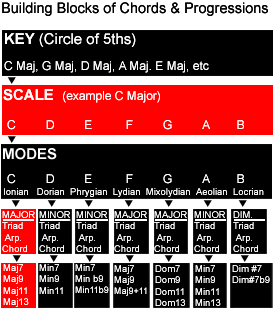
Michael: Here's a graphic that will help explain the breakdown
of the chord/arpeggio formula, notice how you use the odd numbers of the scale
to build each formula:
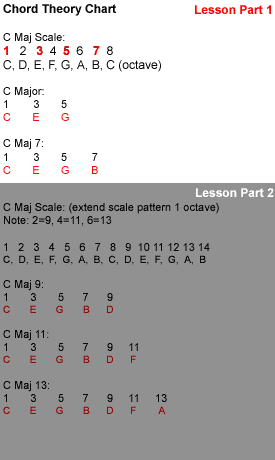
Michael: For the major you take the 1, 3, 5 notes of the scale and then if you want to play a Maj7 you use the 1, 3, 5, 7 notes and so on.
It's basically a math formula. Music patterns and math are related.
phil: How can you play the C Maj 13 ?? There are 7 notes if I read well.
Michael: We'll get into this in more depth Phil, but you can leave out notes, such as the 3rd or 5th note
giving you: C, E, B, D, F & A, thus leaving out G the 5 note.
rockman: Does an 11th chord still have to include the 9th, teach?.......like in the diagram?......and so on etc..
Michael:
Rockman, typically you would like to keep in key notes like the 9th. When you
leave out or skip later notes they are called "add" notes. We'll work on that later,
now, let's get into it. You can find the notes for the C Major scale all over the neck:
C, D, E, F, G, A, B,
this will help you visualize where you can figure out where the chords can be positions.
First I'll give you all the notes and then we'll break it down into sections.
rockman:
C major....is that the Ionian?
Michael: Yes rockman, don't let this first part overwhelm you click on the "guitar neck" link.
C Major Scale Notes (click guitar neck link)
Michael:
OK, now let's break this down on the fretboard, now here's the notes used in the C Major scale,
arpeggio & chord - C (1), E (3), G (5):
Michael: Let's try the same thing in a different position.
rockman: Same notes...different play structure
Michael: Yes rockman. Now you can use this same concept in another
position starting on the 6th string/8th fret:
Michael: This is the basic of chords. You get this and then you can figure out all kinds of chords, all you have to know is the formula I. E.; 1 3 5, 1 3 5 7, etc.
mark6: So an E chord would be E-G-B?
Michael: Yes mark, now here's 4 various positions you can play the C Maj chord:
C Major - Position 1 (open)
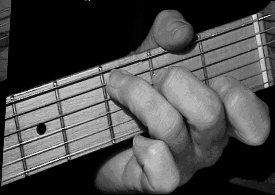
C Major - Position 2 (barre on 5th string)
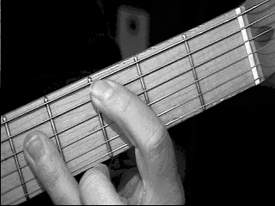
C Major - Position 3 (barre on 6th string)
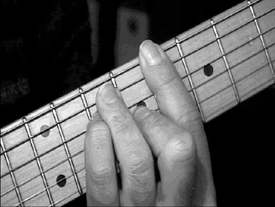
C Major - Position 4 (octave)
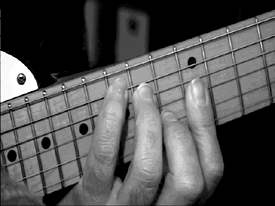
Michael: Here's ALL the various positions you can play the C Maj chord,
use this as a reference to figure out C Maj chord positions on your own:
C Major Chord/Arpeggio Positions
Michael: Can anybody remember what's in the C Maj7?
mark6:
cegb
Glenn:
cegb
Kelzan:
C Maj 7 is a different chord than just C 7, correct?
Michael: Yes C, E, G, B is correct!!! Yes Kelzan
that is correct, C7 is called a dominant chord where you flat the 7th note. Here's the breakdown of the C Major scale, arpeggio and chord:
Michael: Notice I extended the scale pattern 2 octaves to demonstrate how you can use the Maj 7. Here's the Maj 7th on the 8th fret/6th
string:
Michael:
Here's the various positions of the C Maj7 chord:
C Maj 7 - Position 1 (open)
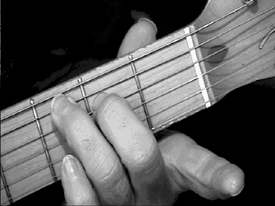
C Maj 7 - Position 2 (barre 5th string)
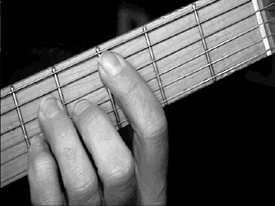
C Maj 7 - Position 3 (barre 6th string)
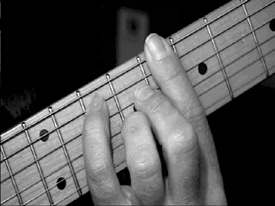
C Maj 7 - Position 4 (octave)

Michael:
Here's the ALL the positions you can play the C Maj7 chord, use this as a
reference to find your own positions:
C Major 7 - Chord/Arpeggio Positions
rockman: Does the
Lydian fit over 7th chords, teach?... I've been leaning that mode lately.
Michael: It does rockman, Does the chart
help clarify this concept?
Susan:
yes!
Kelzan:
It certainly helps, but it must take a lot of practice to see the patterns easily.
rockman: It helps to see it in front of me like this :)
Michael:
Now let's move onto the Maj9, notice in our chart below you extend the C Major
scale "two octaves" to visualize the formula for 1, 3, 5, 7, & 9.
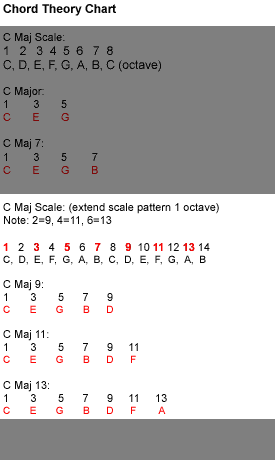
Michael: Here are the C Maj scale, Maj 9 arpeggio and chord - C (1), E (3), G (5), B
(7) & D (9):
rockman: The B sounds really nice as a kind of 'tonic' when played over a Cmaj7, during a solo......
I'm just tryin' it now :)
phil: Sounds sad
Michael: Yes, it gives the chord a jazzy type sound, here's another position for the Maj
9:
Michael:
Here are the various positions you can play the chord:
C Maj 9 - Position 1 (open)
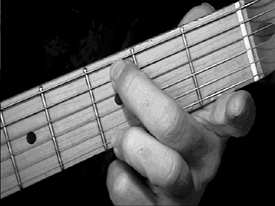
C Maj 9 - Position 2 (barre 5th string)
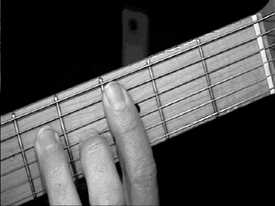
C Maj 9 - Position 3 (barre 6th string)
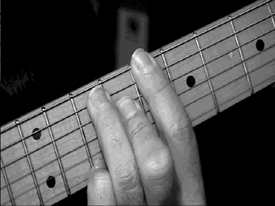
C Maj 9 - Position 4 (octave)
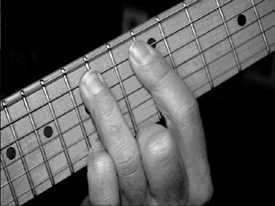
Michael: Now here are ALL the positions you can play the C
Maj9 chord and arpeggios, use this as a reference to figure out your own chords.
C Major 9 - Chord/Arpeggio Positions
lebaron: Yeah, this seems so fundamental, I'm surprised nobody explains this, it makes it all make sense
Michael: That's what I love to hear, that you are getting these concepts.
mark6: You know
I always that this was just so much blah blah blah but boy what was I thinking
Michael: This will open the whole fretboard to you.
You will see all kinds of patterns,
see how the "D" adds to this chord/arpeggio. It's another cool chord used in jazz.
phil: Do we have to play the 9 with only one finger ?
Michael: You can find alternatives in the next tab files. Phil, yes, that is barred by 1 finger.
jlancaster: Kinda like the POLICE (9ths) ?
Michael:
Jl, great ear, that's exactly what type of chords Andy Summer uses. I met him last summer and he is actually a jazz player,
he thought it would be cool to play jazz chords in a rock band, while adding effects to his sound.
Dave Matthews is another great example of a guitar player who uses these chords,
Hendrix too.
Michael: Here's the positions for the Maj 11 - C (1), E (3), G (5), B (7), D (9). F (11):
C Major 11 - Chord/Arpeggio Positions
Michael: For the next few chords well will
use all six strings in order to include as many of the notes of the Maj 11th and
Maj 13th formula. Here's an example of the C Maj 11 barre
chord based on the 6th string/8th fret:
C Maj 11 - (barre 6th string/8th fret)
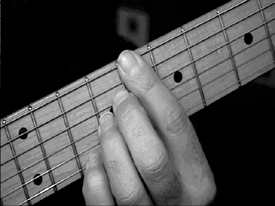
lebaron: The major 11 patterns take up almost the whole neck? It's like all green now?
Well, half anyway.
Michael: You bet Leb, the main thing is to understand is for every chord you know how to play, there are positions all over the neck you can play the same chord
Rhinosaur: You guys should check out Lyle
Ronglien's modes lessons (Understanding Modes), they are good.. and relate to
this stuff.
Michael: Yes Rhino, Lyle's lesson series on
modes will go excellent with this theory class! Here's all the positions for the Maj 13, basically
you can use all the notes in the C Major scale, when playing 13th chords you can
omit the 3rd or 5th note:
C Major 13 - Chord/Arpeggio Positions
Michael: Here's an example on using a barre
chord based on the 6th string/8th fret, notice I use all the notes in the Maj
13, except got the 5th note G this is a dominate note which can be omitted in
this case, it's pretty much the same fingering as the C Maj 11, except you barre
the 1st & 2nd strings on the 10th fret:
C Maj 13 - (barre 6th string/8th fret)
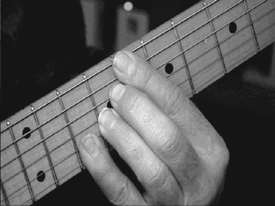
mark6: It makes changes easier when you know the different positions.
rockman: And if you knew all the chord positions, you'd know all the scales for those chords....right teach' ?
Michael: Yes rockman, OK, class time to go, see you at the next Understanding Chords lesson!
bye!
|
<< load notation from left
|